Folklore of Lincolnshire (19 page)
Read Folklore of Lincolnshire Online
Authors: Susanna O'Neill

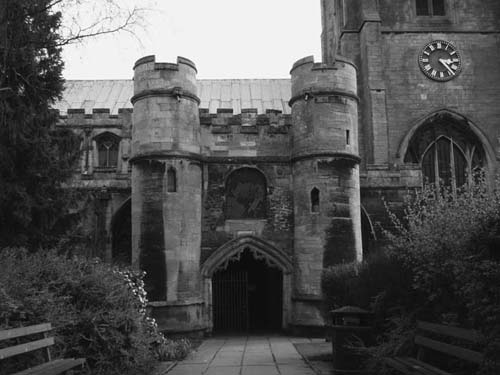
The alleged haunted entrance to the All Saints’ Church at Holbeach, where the ghosts beckon drunkards to their doom.
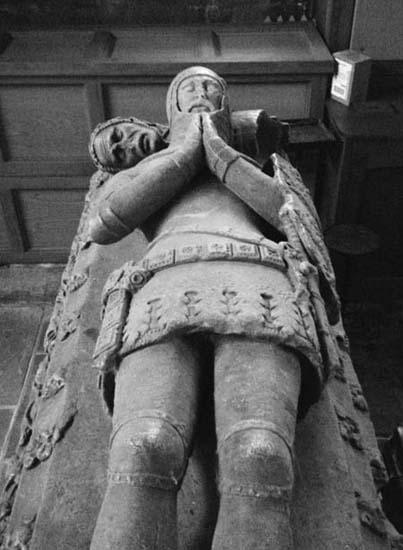
The effigy of Sir Humphrey Littlebury, who is thought to haunt All Saints’ Church, Holbeach.
Commenting on the story, Codd’s research has shown the surnames of each man to be historically accurate, so the men did exist but their fate is unknown. He gives the explanation that the three men could have been heard making a din in the church that fateful night and were set upon by grave robbers or thieves, and thus met their end. As for shadows beckoning others to follow, you will have to make up your own mind.
These ghosts of Holbeach’s All Saints’ Church are said to share their haunting with the phantom of Sir Humphrey Littlebury. His praying effigy from the late fourteenth century lies in the church and this date seems to show seniority for the haunting.
Folklorists Gutch and Peacock tell of another interesting haunting in Ravendale.
13
They say that in the winter time, a headless man has been seen leaving the ruins of a little church, then walking down the valley. If one were to keep watching, he later returns seemingly happy, with his head under his arm! Whether the state of his mood is ascertained from his gait or the decapitated, smiling head is unclear, but he continues on, resting on a wall where he then utters loud cries of joy. They even say on a certain occasion, a man saw the spectre and actually held the gate open for him, which he passed through, without further ado.
One cannot write about ghosts in Lincolnshire without mentioning Lincoln Cathedral. Such a spectacular building with so much history is bound to collect a few wandering spirits. There have been reports of a ghostly procession of praying monks haunting the Cloisters. The figure of a monk is seen on the steps of the cathedral, and then turns and wanders back inside, sometimes with a chain hanging from his neck. Sightings of a spectre falling from the spire, as he may have done in life, have been recorded, and an immovable bloodstain is said to remain on the floor where a stained-glass-window master fell to his death after jumping from the gallery.
Perhaps the most well-known haunting is that of Robert Bloet (1094–1123). He was the second Bishop of Lincoln Cathedral and his ghostly horn is said to be heard echoing around the walls. He was not a popular man and there is a legend that he was cursed by Roger the Hermit, a monk from St Albans. This monk had given refuge to a girl, Christina of Markyate, who had run away from her husband
seeking a life of celibacy. Bloet thought it improper for the girl and the Hermit to live together, saying, ‘Bold and insolent…your cowl alone sustains you.’
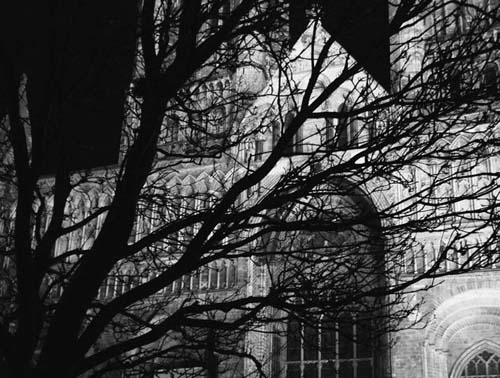
The popularly haunted Lincoln Cathedral.
Roger is said to have made a reply indicating that Bloet would meet an unhappy end and would pray for one in such a cowl but it would be too late. Bloet did meet an unhappy end, being struck down with apoplexy and dying rather swiftly while out riding with the King.
Codd says that the church keepers at the cathedral were forced to perform an exorcism of sorts after his death to eradicate the spirit of Bloet, which had been roaming the building and causing unpleasantness. Even though his spirit has not been seen recently, the horn can, apparently, still be heard on occasion.
The St Peter and St Paul Church at Caistor is also thought to be haunted by a musical religious figure. The ghost of a monk has been reputed to play the organ in the church at night. One vicar, in 1967, tried to quell gossip by placing a cassette player in the church to try and record the sounds, or at least prove there were no sounds to record. He then locked and sealed the building, but when he played the tape back the next day, not only was there organ music to be heard but the sound of footsteps walking through the church, plus strange banging noises too.
As well as old churches and cathedrals, ghosts tend to haunt places that were poignant to them in life. There are many railway hauntings in Lincolnshire, either due to terrible train crashes or workmen who were killed on the lines. Polly Howat
14
talks of countless Fenland hauntings in her book, many that cross the border into Cambridgeshire or Norfolk, but in one she relays the story of a young boy who saw a ghost at Skegness railway station. It was 1978 and the boy, Mark, was doing some school work in an empty train at platform 6. He was a regular visitor, with family in the railway industry, so the staff knew him and allowed him to sit in the empty cars when he wanted. On this particular Sunday his train was the Shrewsbury excursion train, not due to leave for three hours and none were due to arrive for two. There were no other passengers in the station and the gates were locked from the departure side.
It was with the utmost surprise then, that when Mark rose from his seat he came face to face with an old lady standing in the same coach as he. She was apparently wearing a very old-fashioned purple dress and had a quizzical expression on her face. Knowing all the train timetables, he asked her where she was going, but she didn’t reply and a second later she vanished. He exited the train, checking the platform but she was nowhere to be seen and the gates were still locked. He would have been a brave boy indeed to go back and continue with his homework!
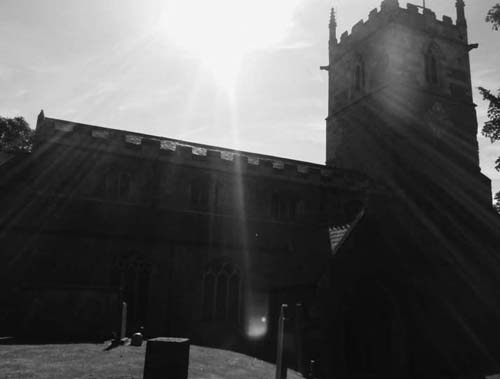
The supposedly haunted St Peter and St Paul Church, Caistor.
Codd also lists a number of railway hauntings on his website.
15
He says that even though it has been closed up and abandoned for years, the signal box at Claxby is said to give out signals to Market Rasen. At Elsham there was a signalman who would hear strange, unexplained noises in the small hours. Early one day he heard
a bicycle pull up and stop outside the box, but when he opened the door no-one was to be seen. At Elsham Ancholme Bridge a steam locomotive is said to appear, just where several people had been killed in a fatal accident in the 1920s. At Holten-Le-Moor the gate-locking lever in the signal box is reported to ease itself out of the frame for no apparent reason.
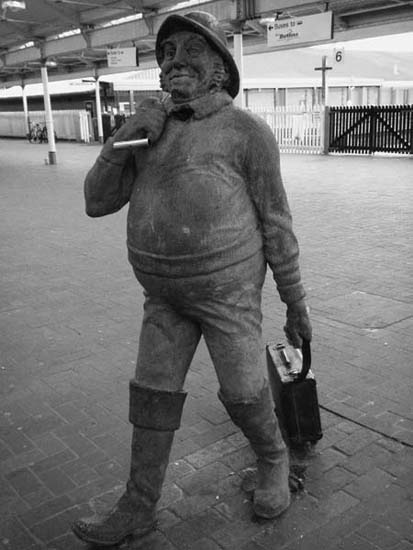
Platform 6, seen here behind the statue of a friendly traveller at Skegness railway station.
It is not just railways – there seem to be a plethora of haunted roads in Lincolnshire, which is no surprise given the number of accident black spots in the county. There was a very interesting
Richard and Judy
show in 1998 when their special guest was the Reverend Fanthorpe from Fortean TV. A man, Kevin Whelan, rang in clearly very shaken about an experience he had just had driving along the A15. Up ahead, just before the left turn to Ruskington, he saw some white lights. Before this incident he never believed in ghosts or the supernatural and was the first to look for a reasonable explanation, so he did not give the lights much thought, believing them to be headlights. As he drew near, however, a face suddenly appeared on the windscreen of the driver’s side, with its left hand held up. He described it as having dark hair with olive-grey skin and a pitted face, giving the whole image the semblance of a photographic negative. Kevin was understandably terrified and did well to keep the car on the road. He says the figure must have stayed with him for nearly a full minute before moving down the side of the car and fading away.
After doing some research, Kevin found out that there had been a terrible motorcycle accident there in the last eighteen months, where the rider had died after losing both his legs. He wondered if it had been a warning to slow down, as he had been slightly over the speed limit.
In the same show, two other callers rang in to say they had experienced the same thing in that exact spot. The next show carried on the story, as apparently up to sixty more people had rung in with similar accounts of that same place. Some of the accounts went back ten or fifteen years, so the recent motorcycle accident was not the cause. A follow-up investigation of the area discovered a hermit used to live there and had been run over by an army lorry during the Second World War. Also, in the past highwaymen would hold up stagecoaches in this spot. So perhaps the raised hand could be seen as a cry for help, a warning or a hold-up, but Richard seemed to think it had more sinister connections, as every encounter caused a feeling of fear.
Another reportedly haunted road is the A16, near Walmsgate. Starting in the 1950s, motorists were purportedly witnessing a green glowing mist arising out of an old sandpit and then drifting across the road. Sometimes the mist took the shape of a man before it disappeared into fields on the side of the road. The area became known as Green Man Pit as the sightings became more regular.
A ghost haunted a lane in Boston, but not because of a traffic accident. The
Lincolnshire Life
magazine from 1998 retells the story that was current in 1912 about a miller lad and a baker boy who became friends in Boston.
16
They both had cruel, hard masters and after work they would often meet up and talk about running away overseas together. One day, the miller boy was late to work and his master punished him by throwing him in the marketplace stocks, as an example to all his other workers. People in the busy marketplace jeered at him and threw rotten fruit and small stones at him, but his baker friend was in the crowd and heard his cry. He went to see him and gave him a small loaf of bread as some comfort. The miller boy was very grateful. However, the baker found out and punished the baker lad for stealing his bread. He had him hanged on a gibbet on the crossroads. When the miller boy was eventually freed, he heard about his poor friend’s demise and as a sign of their friendship, he ran away to sea as they had both dreamt about. The next spring, a robin built a nest in the jaw of the hanging baker boy’s body and began to sing. Straight away people recognised the whistle as that of the baker boy, who used to always whistle while he worked. Rumour spread that he had returned to haunt the baker for the rest of his days, and the baker became so afraid that he dared not pass by the gibbet anymore. It is said that day and night the baker could not get the sound of the bird’s whistle out of his head and he eventually lost his mind completely, and consequently all his business too. Belief in Boston is that Gibbet Lane is named after the memory of the baker boy, although his spirit rests in peace now he has found justice.